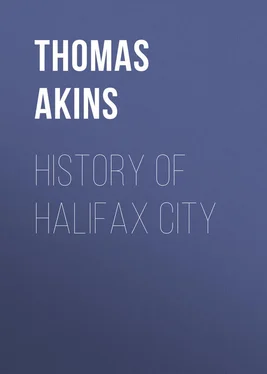Thomas Akins - History of Halifax City
Здесь есть возможность читать онлайн «Thomas Akins - History of Halifax City» — ознакомительный отрывок электронной книги совершенно бесплатно, а после прочтения отрывка купить полную версию. В некоторых случаях можно слушать аудио, скачать через торрент в формате fb2 и присутствует краткое содержание. Жанр: foreign_antique, foreign_prose, Историческая проза, на английском языке. Описание произведения, (предисловие) а так же отзывы посетителей доступны на портале библиотеки ЛибКат.
- Название:History of Halifax City
- Автор:
- Жанр:
- Год:неизвестен
- ISBN:нет данных
- Рейтинг книги:3 / 5. Голосов: 1
-
Избранное:Добавить в избранное
- Отзывы:
-
Ваша оценка:
- 60
- 1
- 2
- 3
- 4
- 5
History of Halifax City: краткое содержание, описание и аннотация
Предлагаем к чтению аннотацию, описание, краткое содержание или предисловие (зависит от того, что написал сам автор книги «History of Halifax City»). Если вы не нашли необходимую информацию о книге — напишите в комментариях, мы постараемся отыскать её.
History of Halifax City — читать онлайн ознакомительный отрывок
Ниже представлен текст книги, разбитый по страницам. Система сохранения места последней прочитанной страницы, позволяет с удобством читать онлайн бесплатно книгу «History of Halifax City», без необходимости каждый раз заново искать на чём Вы остановились. Поставьте закладку, и сможете в любой момент перейти на страницу, на которой закончили чтение.
Интервал:
Закладка:
Early in the month of July, a spot for the settlement was pitched upon near Point Pleasant, 10 10 "From seeing the place only, one would be apt to choose Sandwich Point as the best situation for a town, being very defensible and having the advantage of Sandwich River, (now known as the North West Arm), navigable a great way. This was the general opinion at first, and they began to clear there, the first day they worked, but upon examination we found the strongest objections against it." — Governor Cornwallis' letter to Board of Trade.
then called Sandwich Point, and people were employed in cutting down the trees; but the want of sufficient depth of water in front, its great exposure to south-east gales and other inconveniences being discovered, it was abandoned for a more eligible situation to the northward, commanding a prospect of the whole harbour and on an easy ascent with bold anchorage close to the shore. Here Mr. Bruce the engineer, and Captain Morris the surveyor, were ordered to lay out the town, which was surveyed, the plan completed and the lots appropriated to their respective owners by the 14th September. The town was laid out in squares or blocks of 320 by 120 feet deep, the streets being 55 feet 11 11 The streets are supposed to be 60 feet broad, but none of them are found to exceed 55 feet in width.
in width. Each block contained 16 town lots, forty feet front by sixty deep, and the whole was afterwards divided into five divisions or wards, called Callendar's, Galland's, Ewer's, Collier's and Foreman's divisions, after the names of the persons who were appointed Captains of Militia, each ward being large enough to supply one company.
Buckingham Street was the north and Salter Street the south limit, and the whole was surrounded by a strong palisade of pickets with block houses or log forts at convenient distances. Foreman's new division was afterwards added as far as the present Jacob Street. The north and south suburbs were surveyed about the same time, but the German lots in the north were not laid off till the year following.
Great difficulty was at first experienced in the erection of dwellings; the European settlers being totally unacquainted with the method of constructing wooden buildings. Frames and other materials for building were, however, soon brought from Massachusetts, and before the cold weather set in a number of comfortable dwellings were erected. Provisions and other necessary supplies were regularly served out in the camp, and every exertion on the part of the Governor made to render the settlers comfortable before the approach of winter. Several transports were detained and housed over to accommodate those settlers whose houses were not complete, and the canvas tent and log hut were soon abandoned for more convenient and comfortable accommodations.
I have, says Governor Cornwallis, in his letter of the 20th August, contracted for frames and materials for barracks and officers' lodgings from Boston. Boards are very high owing to the drought. I have got none under £4 per thousand, and shall be obliged to furnish a vast number to help the people to get under cover, and have sent an officer on purpose to Boston to obtain them at a fair price. Many houses are begun and huts and log houses already up for more than half a mile on each side the town.
Tradition says that on clearing the ground for settlement a number of dead bodies were discovered among the trees, partly covered by the underwood, supposed to have been soldiers of the Duke D'Anville's expedition which put into Chebucto Harbor in 1746, 12 12 The remnant of this formidable fleet which was destined for the destruction of the British settlements of Acadia and New England, put into Chebucto Harbor in distress in September, 1746. The troops it is said were encamped on the western side of the Basin, near the small Cove about 4 miles from town, which still bears the name of the French Landing. The Duke died of grief at the failure of the expedition, and the Vice Admiral Destourville, ran himself through the body, and was buried on George's Island. His remains, or what was supposed to be have been, were afterwards removed to France by his family. Several of the ships of war were sunk on the eastern side of the Basin. The hulls of these vessels were visible in calm weather about 50 years ago, but they have long since disappeared. M. Jonquiare, afterwards Governor of Canada, was also in this expedition.
but the Governor in his letter does not mention the facts.
During the winter months the people were kept actively employed in cutting pickets for fences and wood for fuel, and for erecting new buildings. Mechanics were placed at the head of working parties to direct their labours, and by a judicious division of the people into small parties the more laborious portion of the work was executed with uncommon dispatch. Mills were also erected at the expense of Government for sawing lumber, and a mill master appointed with a salary, and every facility held out to enable those settlers, who had not yet been accommodated, to complete their dwellings on the approach of spring. The Governor in his letter of 27th July, describes the site of the Town as very advantageous. He says: "It has all the conveniences I could wish except a fresh water river. 13 13 At this period when the settlement was confined to such narrow limits the brook known to us as Fresh Water River, in the south suburbs, was considered to be at a distance too far from the pickets to be of much value as a means of supply to the settlers.
Nothing is easier than to build wharves; one is already finished for ships of 200 tons. I have constantly employed all the carpenters I could get from Annapolis and the ships here to build log houses for stores. I have likewise offered the French at Minas considerable wages to work, and they have promised to send fifty men to remain until October. As there was not one yard of clear ground you will imagine our difficulty and what we have here to do; however, they have already cleared about 12 acres, and I hope to begin my house in two days; I have a small frame and pickets ready."
The following extracts from a letter dated 25th July, 1749, written by a settler, 14 14 This letter appeared in one of the British periodicals for October, 1749.
affords several interesting facts relative to the state of the settlement at this time: – "On our arrival we found the Sphinx, of 20 guns, which had come into harbor a few days before us; as I write the transports are entering the harbor with the two regiments of Hopson and Warberton on board from Louisburg. The assistance, as well as the security we shall receive from them, will greatly forward our settlement; the officers have brought all their furniture, a great number of milch cows, and other stock, besides military stores. We have already cleared about 20 acres, and every one has a hut by his tent. Our work goes briskly, and the method of employing the people in ships' companies has a good effect, and as the Governor is preparing to lay out the lots of land, we shall soon have a very convenient and pleasant town built, which is to be called Halifax. There are already several wharves built, and one gentleman is erecting a saw mill; public store houses are also building, and grain of various sorts have been sown. We have received constant supplies of plank and timber for building, and fresh stock and rum in great quantities, 20 schooners frequently coming in in one day. We have also a hundred cows and some sheep, brought down to us by land, by the French at Minas, which is about 30 miles distant from the bottom of the bay, and to which we purpose to cut a road. The French Deputies who came to make submission have promised to send us 50 men for this purpose, and to assist us as far as they are able; we have received the like promise, and friendship and assistance from the Indians, the chief having been with the Governor for that purpose. In short, every thing is in a very prosperous way. But I should be equally unjust and ungrateful, were I to conclude without paying the tribute which is due to our Governor. He seems to have nothing in view but the interest and happiness of all; his zeal and prudent conduct in the difficult task assigned him cannot be too much admired."
Интервал:
Закладка:
Похожие книги на «History of Halifax City»
Представляем Вашему вниманию похожие книги на «History of Halifax City» списком для выбора. Мы отобрали схожую по названию и смыслу литературу в надежде предоставить читателям больше вариантов отыскать новые, интересные, ещё непрочитанные произведения.
Обсуждение, отзывы о книге «History of Halifax City» и просто собственные мнения читателей. Оставьте ваши комментарии, напишите, что Вы думаете о произведении, его смысле или главных героях. Укажите что конкретно понравилось, а что нет, и почему Вы так считаете.












